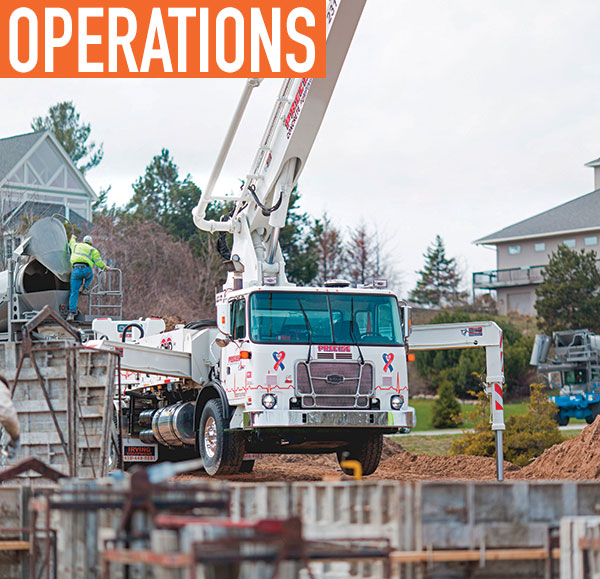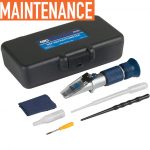Whether adding to your existing truck-mounted concrete boom pump fleet, replacing old rigs, remounting pumps on new trucks, or just getting started with a new business, there are some significant decisions to make. One of the most important is choosing the truck chassis to work with your pump.
I talked to some concrete pumping industry veterans to learn about the new pump truck chassis choices available, and how important that truck purchase decision is in addition to your selection of pumps.
Joe Irving, the founder and president of Irving Equipment in Tiffin, Ohio, has decades of experience with concrete pumps and the rigs that run them. Irving mounts pumps on both Mack and Autocar Class 8 cab-over truck chassis and works with pumper operators coast-to-coast. Also, for some additional real-world operating and maintenance experience, we checked in with Joe Robinson, of Wm. L. Robinson Concrete Contractors, and his fleet maintenance lead, Tim Boyle. Both have hands-on experience with the latest pump chassis available.

Concrete pump trucks, such as this Autocar ACX, face special challenges on the construction site.
TOTAL COST OF OWNERSHIP
Let’s start with the essential point: total cost of ownership (TCO). Acquisition cost is a one-time investment. TCO, however, extends over the lifetime of your truck and significantly impacts your true profitability.
Maintenance costs and parts pricing might be the obvious considerations in TCO. But, you might be surprised that the chassis choice you make to mount your pump can really pay off: improved reliability, uptime, safety, driver comfort, and the benefits—yes, benefits—of the latest emissions systems.
One question that affects both acquisition costs and TCO is whether you need to settle for a chassis sitting in dealer inventory that will have to be modified to accept your boom pump. A much better option is to have a new truck custom-engineered and custom built just for your pump model and your specific needs. I’ll talk about that critical decision in a minute.
ENGINES & TRANSMISSIONS
The engine is the absolute heart and soul of your new truck-mounted concrete boom pump. Not only does it get your crew to the jobsite, it powers your pump. That means you need a reliable power plant with the right torque curves for both scenarios.
Evidenced by its growing market share in many concrete pump applications, the Cummins ISX 12 delivers higher torque and hp, with lower fuel consumption, fewer manual regenerations, and lower maintenance costs than the old industry standard engine. In addition, no other diesel engine offering has as many authorized service, warranty, and parts locations in North America as Cummins.
A lot of us old-timers cut our teeth on manual transmissions. Experienced operators can run through the gears like nobody’s business. But, many new operators don’t have that experience. Pumps are one of the few vocations still using manual transmissions, but the trend over the last five years has been toward modern advanced automatic transmissions.
Consider automatic trannies for your new rigs. That will take one more thing off your driver’s plate, increase options for hiring drivers, and reduce driver fatigue overall—bigtime. Another plus? Automatics can apply full torque even at lower vehicle speeds, which aids in low-traction situations, such as deep sand and loose gravel. Even a seasoned veteran pump driver with a manual can’t outperform today’s modern automatics in this off-road environment. Last, say goodbye to the costly annual clutch repairs associated with manual transmissions.
So, what do the experts say? Irving recommends that you get the power you need for both driving and pumping. “A 450 hp Cummins engine combined with an Allison automatic transmission is a standard Autocar package,” Irving mentions. “You can’t beat that combo for today’s pump truck.”

The Autocar ACX cab provides exceptional visibility and a productive work environment.
DON’T FORGET ENVIRONMENT
Exhaust systems use stack heat to operate the emissions processes and, historically, many operators experienced problems in this area. You need to consider an aftertreatment system designed specifically for your application.
Vocational trucks, especially concrete pumps, which operate while stationary, require specialized engineering to avoid excessive regenerations. This is an area where Autocar and its custom-engineering approach have a clear advantage. Autocar’s back-of-cab exhaust design not only provides better driver visibility, it delivers lower costs and better uptime with fewer regens required.
CHASSIS CONSIDERATIONS
Vocational vehicles face a specific set of challenges—jobsite conditions are rough, to put it mildly. The chassis must be strong enough to withstand the rigors of both hauling around truck-mounted concrete boom pumps, as well as the constant twisting of the frame once you go off-road. Here’s where a custom-engineered chassis beats aftermarket chassis modification, hands down.
The old system of picking a stock truck out of inventory and re-working it for the chosen boom pump sometimes results in numerous chassis modifications at the pump body company. How about moving the battery box, air tanks, and cross-members, and cutting or welding the frame to modify the wheelbase? Or adding a “tandem steer front end kit” at the last moment? Don’t let anyone do
that to your new truck. Every mod increases the risk of serious and costly problems down the road.
Today’s pumper should be personally engaged in specifying all the custom features and component options on the chassis—not just the pump—down to tire brand and size, brake components, and other supplier options. These decisions can make a significant difference in acquisition price and, just as importantly, improve vehicle uptime and TCO.
In contrast to past industry norms, Autocar strongly encourages operators to let it custom-engineer their chassis so it can be built right the first time, directly on the main Autocar production line. A recent factory tour by Robinson and Boyle made a huge impression when they saw, first-hand, the custom-engineered truck for their pump being built.
“We checked out the raw chassis material and not a single bolt hole was drilled yet,” Robinson mentions. “And, we were told there wouldn’t be until the Autocar engineers had completed the custom design phase specific for our pump model.”
Irving explains another reason why a custom build is important. “A custom chassis can mean avoiding the need for state load permits. Using the right materials and right components can help keep a Class 8 truck within weight regulations,” a huge logistics and cost benefit for years.
The other huge benefit to a custom-engineered chassis is a tighter turning radius. Don’t make your driver fight three-point turns in city traffic. Precise positioning on the jobsite needs a tight turning radius, especially with multiple steer-axle configurations.

Autocar custom-engineered the chassis for Wm. L. Robinson Concrete’s new 45-meter CIFA pump to avoid the need for load permits.
CAB OR COMMAND CENTRAL
I hate to state the obvious, but the cab is more than just a place to keep the brake and gas pedals and steering wheel. It’s an operations hub for your driver, serving as his mobile office.
Going with a cab-over is a no-brainer. Not only will you get superior maneuverability, it puts the driver right out front—where the action is. An unobstructed view is critical to driving safety and precise positioning. But, choose the right cab-over.
A wrap-around windshield will give you superior visibility as it eliminates blind spots. And, don’t forget the rear window. Autocar uses a one-piece back glass and standard curved corner windows for greater visibility on both the road and jobsite.
The more easily your driver can see obstructions—and pedestrians—the less likely accidents will put a “dent” in your operation.
Make sure you choose a cab design that allows for safe, comfortable, and ergonomic ingress and egress. Some things to look for are ergonomic step design and wider doors.
Speaking of wider doors, don’t forget that your drivers come in all shapes and sizes. A cab should be designed for everyone’s comfort. This includes an adjustable, tilting and telescoping steering column.
PARTING SHOTS
Boyle reminded me of a few maintenance concerns that I know all too well. Don’t take for granted the benefits of a top-notch onboard diagnostic system and easy access for maintenance. Boyle explains, “Honestly, I’ve worked on Macks for years and know my way around. When Jeff Robinson was considering an Autocar rig, I had questions. But, Autocar has a great cab-over design that tilted open more for easy access. And, the cab interior components were easy to get to for repairs. Service after the sale is top notch.”
Tech support directly from your chassis OEM factory might be the biggest difference of all, and one that you might not be used to. The Autocar Solutions technical support service has the goal of avoiding a trip to the dealer if possible, and getting trucks back into service faster. It’s available to all Autocar owners at no charge and operates after hours, as well.
Whatever concrete boom pump you buy, put just as much thought into selecting the truck chassis that gets it from your yard to the jobsite and back. After all, you can’t make any cash if it’s sitting on the side of the road or hobbled up in the shop.
Your profitability depends on it.
FOR MORE INFORMATION:
Steve Maurer, IME, is a business writer with more than 30 years’ experience in the industrial maintenance, electrical, and safety sectors.
_______________________________________________________________________
MODERN WORKTRUCK SOLUTIONS: DECEMBER 2016 ISSUE
Did you enjoy this article?
Subscribe to the FREE Digital Edition of Modern WorkTruck Solutions magazine.
![]()




